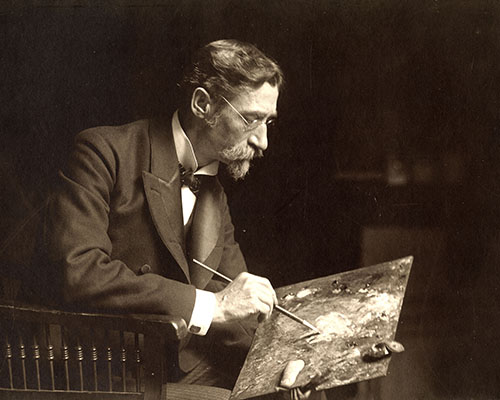Who was T.C. Steele?

Where most people only saw simple scenes of the back country, T.C. Steele saw a Masterpiece.
Within his own lifetime, Theodore Clement “T.C.” Steele gained a national reputation as one of the most celebrated American Impressionist painters of the early 20th century – an artist who followed the call of the wild. He built a hilltop sanctuary and studio deep in the forests of south central Indiana. It was within this wooded cathedral that Steele spent his days in communion with his natural surroundings, creating stunning canvases that celebrated the environment and man’s personal relationship with it.
Early Inspiration
Steele was only 14 years old in 1861 when his father died in Waveland, Indiana. As the oldest of eight children, he began working extra hours in the fields to support his family. However, his mother insisted that Steele also take coursework in the arts, music and culture at the Waveland Academy, about 70 miles west of Indianapolis. While at the Academy, Steele met and eventually married Libbie Lakin, herself an artist, musician and poet. Together T.C. and Libbie raised a family of three children as Steele embraced the immense challenge of making a living as an artist in the Midwestern U.S. during the late 19th century.
Steele worked primarily as a portrait artist, living off a few commissions from wealthy patrons. To improve his skills, he determined that he needed to attend one of the celebrated art academies in Europe. In 1880, with his young family in tow, Steele gathered contributions from wealthy art patrons who helped pay for his tuition and travel to the Royal Academy in Munich from 1880-1885.
Painting in Plein Air
It was in Munich that Steele dove deep into the plein air painting style (painting outdoors). While Steele worked for several more years in portraiture, his passion, vision and skills as a plein air painter were growing rapidly. After winning some prestigious awards at the Royal Academy, Steele decided to return with his family to the U.S. and cultivate his skills and passion for plein air artwork.
After returning from Europe, most Midwestern artists set up studios along the East Coast in art colonies such as Nantucket and the Hudson Valley. But Steele, along with a few of his fellow Hoosier painters, decided to establish their careers in the Midwestern territory they knew and loved. One Chicago art critic dubbed Steele and his colleagues “The Hoosier Group,” a name that quickly grew popular in art circles across the country.
Gaining a National Reputation
By the 1890s, Steele’s works were featured in exhibits from New York to Chicago to San Francisco. His paintings were also featured at the 1893 Chicago World’s Fair, in an exhibit hall called “The Impressionists.” Other celebrated works from the great European Impressionists (such as Monet and Renoir) were also on display. The critics in Chicago trumpeted the brushstrokes and rich palette and emotion exhibited in Steele’s works – all of which helped launch a large national following.
Often Steele would partner with other members of the Hoosier Group to stage presentations and traveling exhibits. Art critics and columnists from the major national newspapers – from the New York Times to the San Francisco Chronicle – marveled at how Steele and his contemporaries could capture the subtle beauty of the quiet Midwestern landscapes.
House of the Singing Winds
Steele’s life was not without heartbreak. In 1899, his wife Libbie died of tuberculosis. For years, Steele suffered emotionally, and his canvases often took on a darker tonal quality at this time, as he struggled to move on. Around 1905, Steele was introduced to a family friend, Selma Neubacher, an artist who studied in New York and who was an art teacher in the Indianapolis schools. By 1907, the couple were married, with Steele presenting a wedding surprise to his new bride. Within the rolling hills of Brown County in southern Indiana, Steele had purchased 60 acres of hilltop property in the tiny village of Belmont.
Steele called their new home The House of the Singing Winds, named after the brisk breezes that frequently blew along the porch area. It was here that Steele dove deep into his subject matter, capturing the spiritual essence of his landscapes. Steele was prolific, often painting four or five canvases each and every day. Day after day, season after season, Steele spent his days ensconced in the thick, forested lands around his home. When neighboring farm families would move and sell their property, Steele continued to buy more and more acres in Brown County to help preserve the flora and fauna of his painter’s paradise.
Steele died in July 1926 at the age of 69. At his funeral service at the House of the Singing Winds, his ashes were spread over a quiet, wooded area, on the very ground that was his source of inspiration for years. Above the fireplace mantle at the Steele home are engraved the words from a European poet, “I take off my hat to the beauty of the world.“ It was a saying that not only inspired T.C. Steele, but also reflected the very thing that people today enjoy in his highly textured, deeply vivid artwork.









